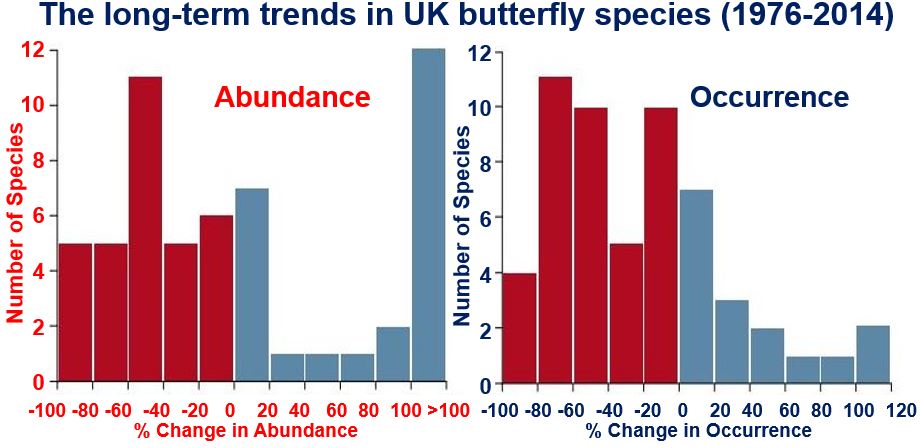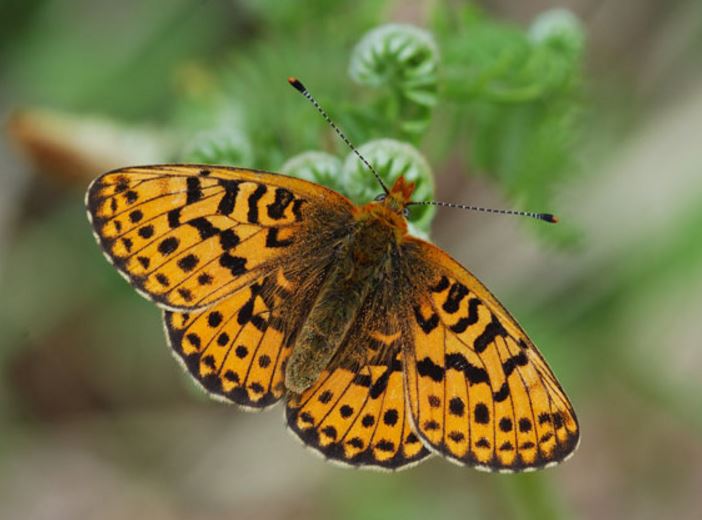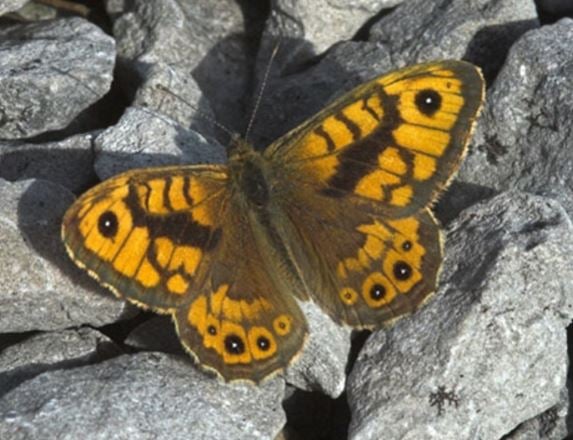UK butterfly populations have declined alarmingly over the last four decades, with three-quarters of all British species suffering significant slumps, a major scientific study reports. Seventy-six percent of Britain’s resident and regular migrant butterflies have declined considerably in abundance, occurrence or both over the past forty years.
The report – The State of UK’s Butterflies 2014 – by the Centre for Ecology & Hydrology (CEH) and Butterfly Conservation, informs that several widespread species, such as the Small Health, Essex Skipper and Wall are now among the most severely declining butterflies in the country.
Conservation efforts really do help
The good news is that some intensive conservation efforts have started to bear fruit, with the fortunes of several of Britain’s most endangered butterflies facing a more promising future.
 ABUNDANCE: Of 33 species with statistically significant UKBMS trends, 61% decreased and 39% increased. OCCURRENCE: Overall, 70% of species (40 in total) had decreased and 30% (17 species) increased in occurrence over the period. All but two of these trends are statistically robust. (Source: The State of UK’s Butterflies 2014)
ABUNDANCE: Of 33 species with statistically significant UKBMS trends, 61% decreased and 39% increased. OCCURRENCE: Overall, 70% of species (40 in total) had decreased and 30% (17 species) increased in occurrence over the period. All but two of these trends are statistically robust. (Source: The State of UK’s Butterflies 2014)
Since 2005, the numbers of the threatened Pearl-Bordered Fritillary have risen by 45%, while those of the Duke of Burgundy (also a threatened species) have increased by 67%.
Silver-studded Blue and Dingy Skipper have shown 19% and 21% increases in occurrence respectively.
The most endangered butterfly, even in the UK, the High Brown Fritillary, has been relatively stable over the past 10 years.
Other species have not done so well
However, despite breakthroughs with some endangered butterflies, the authors revealed that several other species continue to struggle.
The long-term declines of the White Admiral, Wood White and Marsh Fritillary show no signs of changing.
Sadly, some species that were once common and widespread today have become a serious cause for concern.
The Wall, which used to be a common farmland butterfly across the southern regions of the UK, has suffered a 25% decline in abundance and a 36% drop in occurrence in 2005. Its declining trend is likely to continue unless urgent action is taken now, the authors added.
The Gatekeeper, one of Britain’s most abundant species, has suffered a 44% fall in abundance since 2005. Small Skipper numbers have been below average every single year since the beginning of the century.
 The authors of the report wrote “Volunteer recorders are the lifeblood of butterfly recording and monitoring in the UK and without them we would know little about the current state of our butterflies. Whether submitting sightings online or via pen and paper, long-standing recorders and new recruits alike play a vital role and we are extremely grateful to each and every one.” (Source: The State of UK’s Butterflies 2014)
The authors of the report wrote “Volunteer recorders are the lifeblood of butterfly recording and monitoring in the UK and without them we would know little about the current state of our butterflies. Whether submitting sightings online or via pen and paper, long-standing recorders and new recruits alike play a vital role and we are extremely grateful to each and every one.” (Source: The State of UK’s Butterflies 2014)
Intensive farming and woodland management changes main culprits
The main factors believed to be pushing down British butterfly populations are changing woodland management and agricultural intensification, which have both severely undermined butterflies’ habitats.
The authors explain that decreases of butterfly numbers found in the wider countryside are still less well understood. It is possible that pesticide usage and climate change may be harming them more than previously thought.
 The Pearl-bordered Fritillary (Boloria euphrosyne) is one of the earliest fritillaries to emerge in Britain, and can be found as early as April in woodland clearings or rough hillsides with bracken. It flies close to the ground, stopping often to feed on spring flowers such as Bugle. Thanks to conservation efforts, its population in the UK has increased by 45% since 2005. (Image: butterfly-conservation.org)
The Pearl-bordered Fritillary (Boloria euphrosyne) is one of the earliest fritillaries to emerge in Britain, and can be found as early as April in woodland clearings or rough hillsides with bracken. It flies close to the ground, stopping often to feed on spring flowers such as Bugle. Thanks to conservation efforts, its population in the UK has increased by 45% since 2005. (Image: butterfly-conservation.org)
Northern butterflies faring better
Butterflies in the northern regions of the UK appear to have a more promising future compared to their cousins in the south. While populations in England are mostly declining, this is not the case in Scotland, where populations have been stable.
The north-south split is probably because habitat damage has been less severe in the north, while the effects of climate change vary according to latitude, the authors suggest.
More butterflies are coming to Britain from abroad, the report reveals. Since the 1970s, the Painted Lady, Red Admiral and Clouded Yellow – three common migrant species – have all increased significantly in abundance.
Scarce Tortoiseshell and Long-tailed Blue (rare migrants) have arrived in ‘unprecedented numbers’ in the last few years.
Chris Packham, Butterfly Conservation Vice-president, said:
“This report reveals that UK butterflies are in real trouble. Yet again we are presented with sobering evidence that our much-cherished wildlife is in dire straits. As a society we are guilty of standing idly by as once common species, never mind the rarities, suffer staggering declines. This is a situation that should shame us all.”
“The future of the UK’s butterflies does not have to be bleak. This report shows conservation work can and does turn around the fortunes of our most threatened butterflies.”
 The Wall (Lasiommata megera) is aptly named after its habitat of rocks, walls and stony places. Its delicately-patterned light brown undersides provide excellent camouflage against a sandy or stony surface. In hot weather, the male patrols fast and low over the ground, looking for females. In cooler weather, they will seek out sunny spots to bask, and fly up to intercept females or drive off rival males. (Image: butterfly-conservation.org)
The Wall (Lasiommata megera) is aptly named after its habitat of rocks, walls and stony places. Its delicately-patterned light brown undersides provide excellent camouflage against a sandy or stony surface. In hot weather, the male patrols fast and low over the ground, looking for females. In cooler weather, they will seek out sunny spots to bask, and fly up to intercept females or drive off rival males. (Image: butterfly-conservation.org)
Lead report author, Richard Fox, who is also Head of Recording at Butterfly Conservation, said:
“Thanks to tens of thousands of people who help to count butterflies in the UK each year, we have a clear picture of the changing fortunes of these captivating insects. Overall the situation is stark. Most butterflies have decreased since the 1970s and an alarming number of common species have declined severely.”
“On the other hand, trends over the past decade provide grounds for optimism and show that our approach to conserving threatened butterflies can stem and even reverse declines.”
David Roy, who led the Centre for Ecology & Hydrology contribution to the report said:
“We’ve used sophisticated analyses for this latest report, revealing major declines. This is of great concern not just for butterflies but for other wildlife species that share the same habitats. The findings act as a barometer of the overall state of the environment.”
The authors used data collected from two long-running citizen science projects – The UK Butterfly Monitoring Scheme and the Butterflies for the New Millennium.
Report conclusion
At the end of the report, the authors concluded:
“Despite the recent upturns of some threatened species, the recovery of butterflies in the UK is severely limited by a lack of resources.”
“This situation is likely to get worse in an era of reduced Government funding for the environment105. Unless more funds are made available, and more urgent action taken, it seems unlikely that the UK will meet the Aichi targets agreed in the international Convention on Biological Diversity, at least as far as butterflies are concerned. Concerted action by Government bodies working in partnership with the farming industry is desperately needed to halt biodiversity declines and create a healthier environment.”
“This will require further improvements to agri-environment policy with more money going to management that directly benefits biodiversity and the wider environment.”
Butterfly Conservation Video – State of British butterflies
